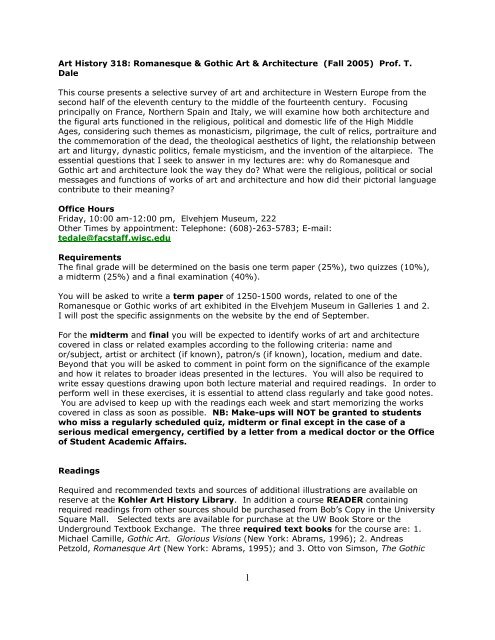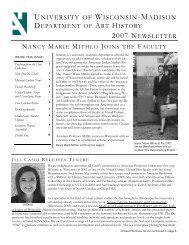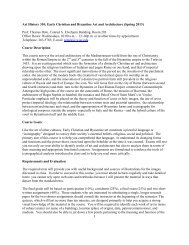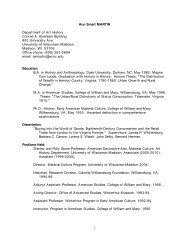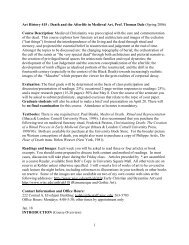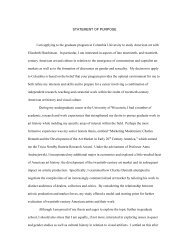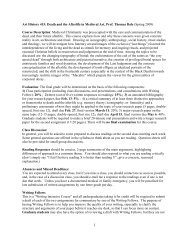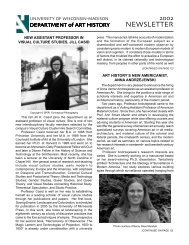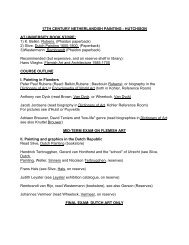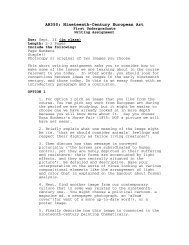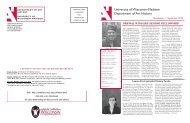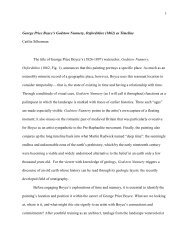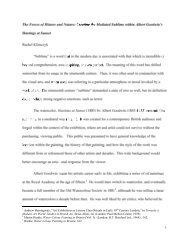Romanesque & Gothic Art & Architecture (Fall 2005) Prof. T. Dale ...
Romanesque & Gothic Art & Architecture (Fall 2005) Prof. T. Dale ...
Romanesque & Gothic Art & Architecture (Fall 2005) Prof. T. Dale ...
Create successful ePaper yourself
Turn your PDF publications into a flip-book with our unique Google optimized e-Paper software.
<strong>Art</strong> History 318: <strong>Romanesque</strong> & <strong>Gothic</strong> <strong>Art</strong> & <strong>Architecture</strong> (<strong>Fall</strong> <strong>2005</strong>) <strong>Prof</strong>. T.<br />
<strong>Dale</strong><br />
This course presents a selective survey of art and architecture in Western Europe from the<br />
second half of the eleventh century to the middle of the fourteenth century. Focusing<br />
principally on France, Northern Spain and Italy, we will examine how both architecture and<br />
the figural arts functioned in the religious, political and domestic life of the High Middle<br />
Ages, considering such themes as monasticism, pilgrimage, the cult of relics, portraiture and<br />
the commemoration of the dead, the theological aesthetics of light, the relationship between<br />
art and liturgy, dynastic politics, female mysticism, and the invention of the altarpiece. The<br />
essential questions that I seek to answer in my lectures are: why do <strong>Romanesque</strong> and<br />
<strong>Gothic</strong> art and architecture look the way they do? What were the religious, political or social<br />
messages and functions of works of art and architecture and how did their pictorial language<br />
contribute to their meaning?<br />
Office Hours<br />
Friday, 10:00 am-12:00 pm, Elvehjem Museum, 222<br />
Other Times by appointment: Telephone: (608)-263-5783; E-mail:<br />
tedale@facstaff.wisc.edu<br />
Requirements<br />
The final grade will be determined on the basis one term paper (25%), two quizzes (10%),<br />
a midterm (25%) and a final examination (40%).<br />
You will be asked to write a term paper of 1250-1500 words, related to one of the<br />
<strong>Romanesque</strong> or <strong>Gothic</strong> works of art exhibited in the Elvehjem Museum in Galleries 1 and 2.<br />
I will post the specific assignments on the website by the end of September.<br />
For the midterm and final you will be expected to identify works of art and architecture<br />
covered in class or related examples according to the following criteria: name and<br />
or/subject, artist or architect (if known), patron/s (if known), location, medium and date.<br />
Beyond that you will be asked to comment in point form on the significance of the example<br />
and how it relates to broader ideas presented in the lectures. You will also be required to<br />
write essay questions drawing upon both lecture material and required readings. In order to<br />
perform well in these exercises, it is essential to attend class regularly and take good notes.<br />
You are advised to keep up with the readings each week and start memorizing the works<br />
covered in class as soon as possible. NB: Make-ups will NOT be granted to students<br />
who miss a regularly scheduled quiz, midterm or final except in the case of a<br />
serious medical emergency, certified by a letter from a medical doctor or the Office<br />
of Student Academic Affairs.<br />
Readings<br />
Required and recommended texts and sources of additional illustrations are available on<br />
reserve at the Kohler <strong>Art</strong> History Library. In addition a course READER containing<br />
required readings from other sources should be purchased from Bob’s Copy in the University<br />
Square Mall. Selected texts are available for purchase at the UW Book Store or the<br />
Underground Textbook Exchange. The three required text books for the course are: 1.<br />
Michael Camille, <strong>Gothic</strong> <strong>Art</strong>. Glorious Visions (New York: Abrams, 1996); 2. Andreas<br />
Petzold, <strong>Romanesque</strong> <strong>Art</strong> (New York: Abrams, 1995); and 3. Otto von Simson, The <strong>Gothic</strong><br />
1
Cathedral (Princeton: Princeton University Press, 1989). The following recommended texts<br />
are also available for purchase: James Snyder, Medieval <strong>Art</strong>: Painting, Sculpture,<br />
<strong>Architecture</strong>, 4th-14th Century (New York: Abrams, 1988); Roger Stalley, Early Medieval<br />
<strong>Architecture</strong> (Oxford, 1999); Cecilia Davis-Weyer, Early Medieval <strong>Art</strong>, 300-1150 (Toronto,<br />
1986); Teresa Frisch, <strong>Gothic</strong> <strong>Art</strong>, 1140-c1450 (Toronto, 1987)<br />
Images, Lecture Lists and Website<br />
A website is currently under construction for the course. It will include a printable syllabus<br />
for the entire course and most of the essential images discussed in lectures. It can be<br />
accessed from the Department Homepage at http://www.wisc.edu/arth/materials.html . In<br />
addition, I will e-mail to you prior to each lecture a complete lecture list identifying the<br />
specific monuments or works of art, terms and historical facts presented in class.<br />
Fourth-Credit students will be required to meet with me for discussion of readings and<br />
short presentations focusing on an independent research topic to be developed in the course<br />
of the semester. We will meet on selected Wednesday afternoons, 5-6:30 pm in LVM120. I<br />
also plan to take an obligatory field trip to look at medieval art in the <strong>Art</strong> Institute of<br />
Chicago on Saturday Nov. 16. Please note that the fourth-credit meetings are not review<br />
sessions and are intended primarily for highly motivated art history majors.<br />
Sept. 3<br />
I. Introduction: DEFINITIONS<br />
Readings:<br />
Petzold, <strong>Romanesque</strong> <strong>Art</strong>, 7-23; Camille, <strong>Gothic</strong> <strong>Art</strong>, 9-25.<br />
What are the origins of the terms “<strong>Romanesque</strong>” and “<strong>Gothic</strong>”? What are the standard<br />
formal definitions of <strong>Romanesque</strong> and <strong>Gothic</strong>? Why are these definitions unsatisfactory?<br />
How do both Petzold and Camille seek to redefine these two periods?<br />
Sept. 5<br />
II. <strong>Romanesque</strong> <strong>Architecture</strong> of the Pilgrimage Roads<br />
Readings:<br />
“Pilgrims’ Guide to Santiago de Compostela” in Davis-Weyer, Early Medieval <strong>Art</strong>, 147-56;<br />
Petzold, 115-21; Stalley, Early Medieval <strong>Architecture</strong>, 147-155<br />
What motivated the pilgrimage to Santiago de Compostela? What religious and political<br />
factors were involved in the orchestration of the cult of Saint James? What does the<br />
pilgrims’ guide emphasize in its description of Santiago? How does the architecture of<br />
Santiago relate to that of other major pilgrimage churches in France? How does the<br />
architectural planning facillitate pilgrimage and other functions of each church? What<br />
alternative schemes are deployed for pilgrimage churches elsewhere in Italy and France?<br />
Sept. 10<br />
III. Cistercians and Cluniacs: <strong>Romanesque</strong> <strong>Art</strong> & <strong>Architecture</strong> of the Monastic<br />
Orders<br />
Petzold, 100-114; Stalley, 167-189. Benedictine Rule, excerpts in Medieval Source Book<br />
2
on-line at http://www.fordham.edu/halsall/source/rul-benedict.html .<br />
What are the essential tenets of the monastic life as outlined in the Benedictine Rule? How<br />
is monastic architecture designed to enhance symbolic and functional distinctions between<br />
individual parts of the monastic complex? What are the differences bewteen Cistercian<br />
from Cluniac monasticism and how are these differences manifested in the art and<br />
architecture of the two orders?<br />
Sept. 12, 17<br />
IV. Revelation, Judgement and Spiritual Passage in the French <strong>Romanesque</strong> Portal<br />
(Moissac and Vézelay; Autun and Conques)<br />
M. F. Hearn, <strong>Romanesque</strong> Sculpture, 102-17; 169-91. Linda Seidel, “The Moissac Portal and<br />
the Rhetoric of Appropriation?” in READER.<br />
What are the essential features of the canonical French Romaneque portals according to<br />
Hearn? What is the significance of the iconography (subject matter) for its location at the<br />
threshold of the church? What role do pictorial structure (composition and narrative<br />
disposition) and inscriptions play in the “reading” of the visual imagery? How does Seidel<br />
depart from conventional characterizations of the portal of Moissac? How does the<br />
framework of the porch condition the viewer’s response to the sculptural program as a<br />
whole? How does it ultimately reinforce the assimilation of the viewer’s entry into the<br />
church building with both the biblical journeys and the viewer’s own reception into the<br />
Heavenly Jerusalem at the end of time?<br />
Sept. 19<br />
V. Monstrosity, Corporeal Deformity and Fantasy in <strong>Romanesque</strong> <strong>Art</strong><br />
Bernard of Clairvaux, Apologia to William of St. Thierry in Davis-Weyer, Early Medieval <strong>Art</strong>,<br />
168-170; Schapiro, "On the Aesthetic Attitude in <strong>Romanesque</strong> <strong>Art</strong>," (1947) in <strong>Romanesque</strong><br />
<strong>Art</strong> (New York, 1977/1993), 1-27 and READER; T. <strong>Dale</strong>, “Monsters, Corporeal Deformities,<br />
and Phantasms in the Cloister of St-Michel-de-Cuxa,” <strong>Art</strong> Bulletin 83, no. 3 (2001):402-436<br />
(available both in photocopy on Reserve and in full-text version at<br />
http://wilsontxt.hwwilson.com/pdffull/04407/1Z7G6/3SX.pdf )<br />
What are the origins of the term “fantasy” (phantasy) and how does its medieval meaning<br />
differ from most current definitions? What is the etymology of the term “monster” and how<br />
was it understood by medieval writers? What is Bernard of Clairvaux’s attitude towards art<br />
in general and the representation of monsters and other human and animal subjects in<br />
cloister capitals, in particular? How does Schapiro reinterpret Bernard’s complaint in terms<br />
of artistic creation? How does my own interpretation differ from Schapiro’s? What issues<br />
concerning these images are still left unresolved?<br />
Sept. 24<br />
VI. Eve, Salome and Mary: Defining the Role of Women in <strong>Romanesque</strong> <strong>Art</strong><br />
Petzold, 123-129; Linda Seidel, “Salome and the Canons,” Women’s Studies 11 (1984):29-<br />
66 in READER.<br />
What are the prescribed positive and negative roles for women in medieval Christian<br />
theology and how are they manifested in <strong>Romanesque</strong> art? What is the significance of<br />
3
nudity and corporeal posture in the figure of Eve at Autun? What is the significance of<br />
Salome in the context of the Toulouse capital depicting the Feast of Herod? According to<br />
Seidel, how would this figure have been understood by the intended audience of canons at<br />
the cathedral and how was the narrative represented in a different fashion for the monks of<br />
La Daurade?<br />
Sept. 26<br />
VII. Glorified Bodies: <strong>Romanesque</strong> Cult Images, Saints and Tomb Portraits<br />
H. Belting, “Statues, Vessels, and Signs: Medieval Images and Relics in the West,” in<br />
Likeness and Presence, 297-310 and in READER; T. <strong>Dale</strong>, “Rudolf von Schwaben, the<br />
Individual, and the Resurrected Body in <strong>Romanesque</strong> Portraiture,” Speculum 77, no. 3<br />
(2002):707-743 in READER.<br />
How did the Western church come to accept sculptural images of the Virgin Mary and the<br />
saints, in spite of traditional fears of idolatry? What explains the different approach to Holy<br />
Images in Byzantium and the West? What is the siginificance of the form, material of these<br />
images? To what extent can they be considered to be “portraits”? How do the cult images<br />
of the saints in metalwork suggest an analogy for funerary effigies like that of Rudolf von<br />
Schwaben? How are the theology of resurrection and the special dual status of the royal<br />
body reflected in the form and medium of the effigy?<br />
Oct. 1<br />
VIII. The Warrior Class: Knighthood, Holy Warfare and Crusade<br />
Petzold, 71-85; Staley, 83-101.<br />
What was the political and religious function of the knight in medieval society? How did the<br />
knight gain a special, sanctified status during the Crusades? What allegorical roles did<br />
images of the knight fulfill in <strong>Romanesque</strong> art? How do the chansons de geste and<br />
narratives such as that on the Bayeux tapestry represent feudal, political and religious<br />
values? What were the basic design features of castles in the eleventh to thirteenth<br />
centuries and what symbolic values were embodied in their exterior appearance?<br />
Oct. 3, 8 (QUIZ I on Oct. 3: covers lectures I-VII)<br />
IX. Reform, Renovatio, Ritual and Antiquarianism: Rome and South Italy in the<br />
Eleventh and Twelfth Centuries<br />
Leo of Ostia, Chronicle of Montecassino in Davis-Weyer, Early Medieval <strong>Art</strong>, 135-40, 156-62;<br />
R. Krautheimer, Rome: <strong>Prof</strong>ile of a City (Princeton, 2000), 161-202; E. Kitzinger, “A Virgin’s<br />
Face: Antiquarianism in Twelfth-Century <strong>Art</strong>,” <strong>Art</strong> Bulletin 62.1 (1980):6-19 in READER.<br />
Additional Illustrations: Snyder, 313-33; Demus, <strong>Romanesque</strong> Mural Painting, plates 18-37.<br />
What were the impetus and sources for the artistic revival that took place at Montecassino<br />
during the second half of the half of the eleventh century? What role did Montecassino play<br />
in the artistic revival in Rome after 1100? What were the ecclesiastical and political motives<br />
for the Gregorian reform and the subsequent artistic programs in Rome and what role did<br />
individual patrons play? Why does Rome constitute a special case of antiquarianism? How<br />
is ancient art re-interpreted by medieval viewers? How is the urban space of Rome<br />
Christianised by the ritual of Assumption Day? How does the apse mosaic of Santa Maria in<br />
Trastevere re-present the ritual in concrete form and what is the meaning of the<br />
4
antiquarianism of its iconography? What was particiularly innovative about the theme of<br />
this apse?<br />
Oct. 10<br />
X. <strong>Romanesque</strong> <strong>Art</strong> and <strong>Architecture</strong> and Civic Pride in Tuscany and North Italy<br />
Snyder, 320-33; Petzold, 50-51; Hearn, <strong>Romanesque</strong> Sculpture, 155-63.<br />
How does <strong>Romanesque</strong> architecture in Tuscany and North Italy differ from that of France<br />
studied thus far? How does the disposition of monumental stone sculpture depart from the<br />
French model? How are the roles of civic patron and artist highlighted?<br />
Oct. 15<br />
XI. "Multiculturalism" in Twelfth-century Norman Sicily<br />
Petzold, 85-92, 146-155; W. Tronzo, "The Medieval Object Enigma and the problem of the<br />
Cappella Palatina,” READER<br />
What specific historical circumstances led the Normans to appropriate the artistic forms and<br />
iconography of other Islamic and Byzantine cultures in their royal art and architecture? How<br />
are Islamic forms used differently in other contexts described by Petzold? How does Tronzo<br />
use ritual to explain the unusual combination of distinctive traditions in the Cappella<br />
Palatina in Palermo? How is the “Byzantine” decoration of the sanctuary adapted for the<br />
Norman ruler’s view point? What was the apparent function of the western “nave” space of<br />
the chapel?<br />
Oct. 17<br />
XII. San Marco in Venice<br />
<strong>Dale</strong>, “Stolen Property: St. Mark’s First Venetian Tomb and the Politics of Communal<br />
Memory,” READER. For additional illustrations: Otto Demus, The Mosaics of San Marco in<br />
Venice , 4 volumes (Chicago, 1984).<br />
What motivated the Venetian theft of the relics of Saint Mark from Alexandria? How do the<br />
architectural form and mosaic decoration of San Marco adapt Byzantine prototypes and<br />
why? How and why did the Venetians update their sacred narrative history around the focal<br />
point of Mark’s first Venetian tomb? How was San Marco transformed in the wake of the<br />
Fourth Crusade?<br />
Oct. 22: MIDTERM (covers lectures and readings I-XI)<br />
Oct. 24<br />
XIII. Ornamenta Ecclesiae: <strong>Romanesque</strong> and <strong>Gothic</strong> Metalwork in service of the<br />
Liturgy<br />
Theophilus, Treatise on Divers <strong>Art</strong>s in Davis-Weyer, Early Medieval <strong>Art</strong>,176-178; Petzold,<br />
61-66; R. Calkins, “Metalwork of the Church Treasuries,” in Monuments of Medieval <strong>Art</strong><br />
(New York, 1979),115-132 in READER.<br />
What is the role of the craftsman/artist according the Theophilus’s treatise on Divers <strong>Art</strong>s?<br />
Why did medieval metalworkers acquire a particularly elevated status as artists? What is the<br />
5
meaning of material radiance and how would Theophilus justify such expense in the wake of<br />
criticisms from ascetic minded clerics such as Bernard of Clairvaux? What were the different<br />
techniques were developed in the twelfth and thirteenth centuries? How does the<br />
iconography of individual objects reinforce or explain their functions? What is the meaning<br />
of “typological” interpretation and what does it suggest about the medieval Christian<br />
perception of Judaism?<br />
Oct. 29<br />
XIV. Innovation and Antiquarianism: Abbot Suger and the Origins of the <strong>Gothic</strong><br />
Suger, On the Abbey Church of Saint-Denis & its Treasures in T. G. Frisch, <strong>Gothic</strong> <strong>Art</strong>, 1140-<br />
ca 1450 (Toronto, 1987), 4-13; Von Simson, The <strong>Gothic</strong> Cathedral, 3-20; 21-58; Fernie,<br />
“Suger’s Completion of Saint-Denis” in READER. Rec. and additional illustrations: Bony,<br />
French <strong>Gothic</strong> <strong>Architecture</strong>, 79-98.<br />
What were Abbot Suger’s motivations for the rebuilding of the west facade and choir of the<br />
abbey of Saint-Denis? What are the roles as patron that Suger projects in his narrative<br />
account of the new building campaign? What was innovative about the structure and form<br />
of his additions to the abbey church and its treasury? What theological, political and<br />
personal factors explain Suger’s new architecture? To what extent does Suger respond to<br />
the complaints voiced by Bernard of Clairvaux, his contemporary? How, according to Fernie,<br />
did the new choir also build upon and deliberately integrate elements of earlier architectural<br />
practice in general and the pre-existing fabric of St. Denis itself? How is his reverence and<br />
aesthetic appreciation for the past reflected in the objects of his refurbished treasury?<br />
Oct. 31<br />
XV. The <strong>Gothic</strong> Architectural Revolution in the Ile de France, ca. 1150-1260:<br />
Mysticism & Technology, Epsicopal and Royal Pride<br />
Camille, 27-40; Stephen Murray, Notre-Dame, Cathedral of Amiens (New York, 1996), 1-16;<br />
Beat Brenk, “The Sainte Chapelle as Capetian Political Program” in READER. For images and<br />
video of Amiens see http://www.learn.columbia.edu/Mcahweb/index-frame.html.<br />
How were the components of the elevation and the formal vocabulary of French <strong>Gothic</strong><br />
architecture transformed in the course of the late twelfth and early thirtheenth centuries?<br />
What different factors (politics, theology, technology, visuality) explain the revolutionary<br />
change and rapid diffusion of the <strong>Gothic</strong> style in architecture? How does Camille transcend<br />
the notion of formal development or evolution of form with his theory of visuality? What<br />
new model does Murray propose for understanding the design process at Amiens Cathedral?<br />
How did the cathedral chapters pay for their vast new cathedrals and what social tensions<br />
surrounded their construction? What was the function of the Sainte Chapelle and how did it<br />
serve to reinforce royal authority?<br />
Nov. 5-7<br />
XVI. Chartres Cathedral, High <strong>Gothic</strong> <strong>Architecture</strong>, Stained Glass and Sculpture<br />
Von Simson, The <strong>Gothic</strong> Cathedral, 91-141. Williamson, <strong>Gothic</strong> Sculpture, 1140-1300. (New<br />
Haven, 1995), 11-21, 37-48; J. Welch Williams, Bread, Wine, and Money. The Windows of<br />
the Trades at Chartres Cathedral (Chicago, 1993), 3-18 in READER.<br />
6
Where does the architecture of Chartres Cathedral fit in the formal development of <strong>Gothic</strong>?<br />
How is the cult of the Virgin Mary as principal titular saint of the cathedral constantly<br />
reinforced in the overall programme of decoration–both in sculpture and stained glass?<br />
What formal and iconographic changes are witnessed in the sculpture and stained glass of<br />
the cathedral from the twelfth and thirteenth centuries (contrast Chartres West and the<br />
transept portals)? To what extent do the form and iconography of sculpture and stained<br />
glass suggest fundamental theological and political ideas? How was the rebuilding of the<br />
cathedral financed, what role did different social groups play and how are they represented<br />
in the stained glass program? How does Williams counter traditional interpretations of the<br />
trades windows at Chartres as images of pious donation? What underlying social and<br />
economic tensions existed in thirteenth-century Chartres? How do images of tradesmen help<br />
consolidate clerical authority?<br />
Nov. 12<br />
XVII. English <strong>Gothic</strong> <strong>Architecture</strong> and Visuality.<br />
Gervase of Canterbury, Treatise on the Fire and Repairs to the Cathedral of Canterbury,<br />
excerpt in Frisch, <strong>Gothic</strong> <strong>Art</strong>, 15-23; Snyder, Medieval <strong>Art</strong>, 402-414.<br />
What were the circumstances that led to the introduction of <strong>Gothic</strong> architecture at<br />
Canterbury? What does Gervase suggest about the relationship between the cathedral and<br />
the citizens of the town? What valuable information does he provide both about the building<br />
process and the medieval perception of stylistic difference? How does English <strong>Gothic</strong><br />
architecture depart from the French paradigm (in terms of elevation, ground-plan, facade<br />
design, vaulting etc) as represented by Amiens and Chartres? How can these differences be<br />
explained? What pictorial values are incorporated into English <strong>Gothic</strong> architecture?<br />
Nov. 14<br />
XVIII. Naturalism and Expressionism in Thirteenth Century <strong>Gothic</strong> Sculpture of<br />
Northern Europe.<br />
Camille, 133-161.<br />
What formal changes can be witnessed in later medieval art from the thirteenth to fifteenth<br />
centuries? What historical, theological and social factors explain late medieval “naturalism”<br />
and expressionism?<br />
Nov. 19<br />
XIX. Mysticial Visions and Devotional Images in Northern <strong>Gothic</strong> <strong>Art</strong>, ca. 1290-<br />
1450<br />
Camille, <strong>Gothic</strong> <strong>Art</strong>, 103-131; J. Hamburger, "The Visual and the Visionary: The Image in<br />
Late Medieval Monastic Devotions," Viator 20 (1989):161-82 in READER.<br />
What is a devotional image? How do later <strong>Gothic</strong> mystical visions and devotional images<br />
depart from biblically based images? What roles did nuns and their male supervisors play in<br />
the creation of a distinctive tradition of devotional art? What gender biases led visionary<br />
images to be associated primarily with women?<br />
Nov. 21 (QUIZ II: covers lectures XII-XVIII)<br />
XX. Courtly Love and <strong>Prof</strong>ane Pleasures in Fourteenth-Century France<br />
7
Camille, <strong>Gothic</strong> <strong>Art</strong>, 167-73; R. Randall, "Popular Romances Carved in Ivory," in P. Barnet,<br />
ed. Images in Ivory (Detroit, 1997), 63-79, illustrations, 218-248. Rec. Camille, The<br />
Medieval <strong>Art</strong> of Love, 51-71<br />
What are the principal literary sources of images of courtly love in French <strong>Gothic</strong> art? What<br />
different metaphors are used to describe courtship and how do they reflect mysoginistic<br />
tendencies in medieval society? What iconographic signs gestures constitute the pictorial<br />
language of courtly love? How does this kind of imagery relate to the function of the<br />
objects it adorns? To what extent do these themes of profane love make reference to sacred<br />
art (in style or iconography)?<br />
Nov. 26<br />
XXI. <strong>Gothic</strong> <strong>Art</strong> and <strong>Architecture</strong> and the Rise of the Mendicant Orders in Italy<br />
Pseudo-Bonaventure, Meditations on the Life of Christ, excerpt in READER; J. White, <strong>Art</strong> and<br />
<strong>Architecture</strong> in Italy, 1250-1400 (Harmondsworth, 1988), 21-44; 74-92. M. Trachtenberg,<br />
"<strong>Gothic</strong>/Italian <strong>Gothic</strong>: toward a redefinition" Journal of the Society of Architectural<br />
Historians 50 (1991):22-37 in READER.<br />
Who was Saint Francis and what was revolutionary about the new order that he founded?<br />
How does Italian <strong>Gothic</strong> architecture depart from the French paradigm and what local factors<br />
explain its apparent conservatisim? How does Trachtenburg redefine Italian <strong>Gothic</strong> in more<br />
positive terms vis-à-vis French models? How does Trachtenburg suggest that Italian <strong>Gothic</strong><br />
can be considered a departure from both earlier “historicist” <strong>Romanesque</strong> architecture in<br />
Italy and contemporary “modern” <strong>Gothic</strong> in France. What role did the rise of the mendicant<br />
orders play in the dissemination of <strong>Gothic</strong> architecture in Italy and how was the architectural<br />
planning adapted to the needs of these new orders? What different sources of insipiration<br />
are synthesized in Italian <strong>Gothic</strong> sculpture? How is mendicant spirituality reflected in the<br />
sculpture of the Pisani? How did devotional texts such as the Pseudo-Bonaventure’s<br />
Meditations foster new attitudes in the pictorial representation of the life of Christ?<br />
Nov. 28: THANKSGIVING HOLIDAY<br />
Dec. 3<br />
XXII. Icon to Altarpiece: The Maniera Greca and Italian Painting around 1300.<br />
Frisch, <strong>Gothic</strong> <strong>Art</strong>, 85-88; W. Tronzo, “Between Icon and Monumental Decoration of a<br />
Church: Notes on Duccio’s Maestà and the Definition of the Altarpiece,” in READER. Rec:<br />
Belting, Likeness and Presence, 377-408.<br />
What role did the “maniera greca” (Byzantine art) play in the orgins of the altarpiece? How<br />
did Italian masters adapt Byzantine style and iconography for the altarpiece? What specific<br />
new functions did the altarpiece perform? What was particularly remarkable about Duccio’s<br />
Maiestà? What does the contract for the Maiestà tell us about the relationship bewteen<br />
artist and patron? What was the civic role of the new altarpiece?<br />
Dec. 5<br />
XXIII. Secular <strong>Architecture</strong> and City Planning in the later Middle Ages<br />
8
Camille, <strong>Gothic</strong> <strong>Art</strong>, 57-68; Rec. Calkins, Monuments of Medieval <strong>Art</strong>, 254-64<br />
How was the space of medieval city or town organized? What were the principal focuses of<br />
public space in the city? How were political and ecclesiastical power highlighted within the<br />
city? To what extent did the city and its walls encorporate symbolic values? What are the<br />
principle features of domestic architecture and to what extent did noble families draw on<br />
earlier castle architecture?<br />
Dec. 10<br />
XXIV. The “Waning of the Middle Ages”: Personalised visions of the afterlife, the<br />
Grotesque and the Macabre<br />
Camille, 151-161; Paul Binski, Medieval Death (Ithaca, 1996), 123-63 in READER<br />
Why has it often been assumed that medieval art in the late fourteenth and early fifteenth<br />
centuries was in a state of decline? What new explanations are offered by Camille and<br />
Binski? Why was medieval art in its last phase so preoccupied with death and the macabre?<br />
What new functions did art fulfill in the preparation of the individual for death and<br />
resurrection?<br />
Dec. 12<br />
Conclusions and Review<br />
E. Panofsky, Renaissance and Renascences in Western <strong>Art</strong> (New York, 1960), ch. 3: 114-<br />
161.<br />
What distinguishes the Renaissance of the fifteenth century from the earlier revivals of<br />
ancient art and culture in the Middle Ages? What are the problems with establishing strict<br />
chronological boundaries between Renaissance and Medieval? To what extent do medieval<br />
functions of religious art continue into the Renaissance?<br />
Dec. 17 (Tuesday)<br />
FINAL EXAM, Elvehjem L150, 2:45-4:45 pm.<br />
9


